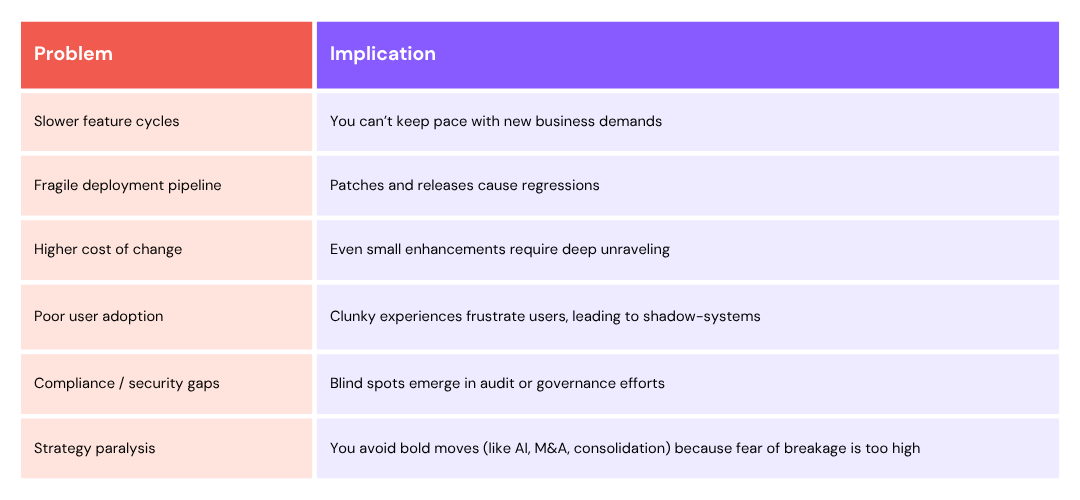
In the age of cloud and SaaS, many organizations believed legacy systems were a thing of the past. But in truth, for many Salesforce orgs, legacy never died - it just transformed. Today, technical debt inside Salesforce is doing exactly what on-prem legacy systems used to do: slowing you down, introducing fragility, and starving your capacity for innovation.
As Slalom’s 2024 AI Research Report notes, outdated practices and brittle foundations are preventing organizations from turning AI’s potential into competitive advantage. In the study, most executives admit they’re still early in their AI journey. Without addressing structural constraints, they risk being outpaced by competitors who modernize first.
In other words, AI doesn’t fail because of algorithms. It fails because of architecture.
As Salesforce leaders eye AI tools like Agentforce to deliver new efficiencies, few are stopping to ask the critical question: Is our foundation strong enough to support it?
Salesforce may be cloud-native, but it’s not immune to accumulation of long-term structural issues. As Salesforce Ben defines it, technical debt is “the cost of additional rework caused by choosing an easy solution now instead of using a better approach that would take longer to develop." In practice, this debt accrues not just in code, but in clicks, automations, overloaded metadata, tangled flows, and outdated org architecture.
Analysts and implementers warn that unchecked tech debt is the “silent killer” of agility: overcustomization, lack of cleanup, inconsistent governance, and legacy patterns slow feature delivery, complicate upgrades, and increase total cost of ownership.
Some common debt in Salesforce includes:
Left unchecked, this debt adds drag within an organization: performance degradation, unpredictable behavior, slow deployments, higher bug risk, and increasing maintenance overhead.
In short: your Salesforce org ceases to be a growth engine and becomes a ball and chain.
Salesforce’s Agentforce platform is designed to embed autonomous and assistive AI agents deeply into the enterprise, across service, sales, operations, and more. These agents rely on clean data, reliable metadata, process logic, and predictable orchestration to act responsibly. In other words, the more tech debt you carry, the more fragile your AI pipeline becomes.
Think about it. If flows and triggers are tangled, business logic is locked in legacy automation technology, metadata is undocumented, and data layers are ungoverned, then agents might misfire, introduce errors, or avoid certain decision paths altogether. That’s a risk. And in AI, reputation matters.
Salesforce itself is pushing deeper into AI tools, including the recent Agentforce Vibes release, which can generate, test, and fix code. But if your org is built on shaky foundations, these powerful tools may amplify problems instead of solving them.
Moreover, analysts are pointing out a real fatigue among customers overwhelmed by AI choices. Without a clear foundation, adoption stalls.
If you leave tech debt unaddressed, these outcomes become real:

It’s like driving your car with the emergency brake on. Eventually, the drag outpaces the speed.
If tech debt is the new legacy, then your modern strategy must start with diagnosis and remediation, not feature chasing. Here’s a simple roadmap:
Your competitors may promise AI transformation or modernization. We believe the differentiator is innovation grounded in clarity. And that clarity starts with understanding your current state, surfacing the hidden legacies, then mapping a strategic path forward. You don’t modernize blindly; you modernize intelligently.
At Dreamforce 2025, along with Slalom, we’re launching the Zero Legacy, Infinite Possibility program with live Hubbl Org Intelligence scans, executive workshops, and a clear path from insight to execution. “Zero Legacy represents a shared commitment between Hubbl and Slalom to help organizations see clearly, act decisively, and lead with confidence in the age of AI,” shared Katie Dunlap, General Manager, Global Enterprise at Slalom.
If you’re wrestling with legacy complexity inside Salesforce today, if you want to make Agentforce or other innovations matter, this is your starting line. Let’s treat tech debt not as a “cost we’ll pay later,” but as the new legacy we retire first.